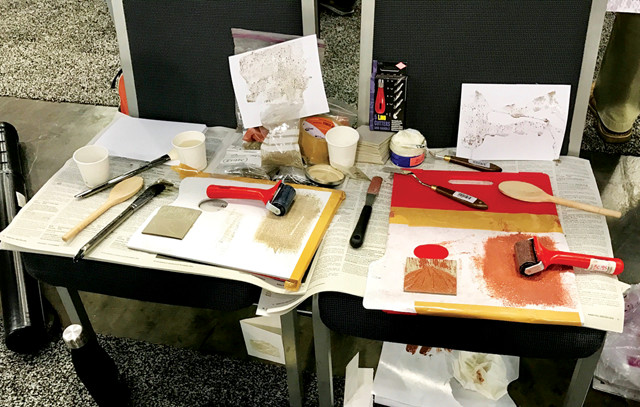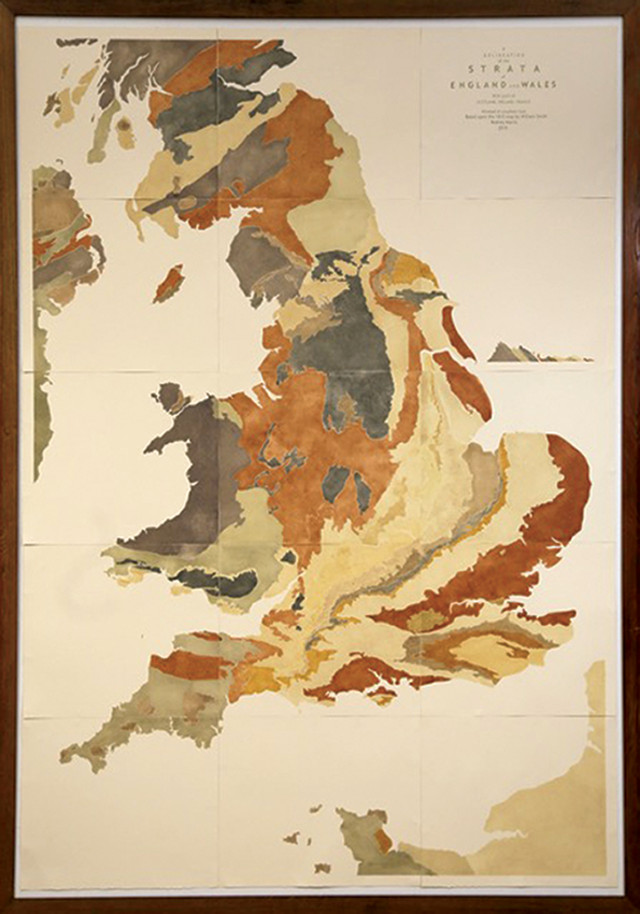
by Harvey Leifert Monday, June 19, 2017

Katharine Cashman, a volcanologist at the University of Bristol in England, presented her research on visualizing earth materials at the American Geophysical Union's 2016 fall meeting. Credit: Harvey Leifert.

An attendee explores the geo-art concepts. The work of other attendees hangs above. Credit: Harvey Leifert.
“Arts and Sciences.” The phrase is familiar to students and faculty on most campuses, often serving as the moniker of colleges or other curricular subdivisions within universities. While the pairing suggests a joint enterprise of some sort between the two fields, it might more aptly be termed, “Arts or Sciences,” as curricula rarely encompass both.
That is not the case at the University of Bristol in England, however, where geoscientists and artists are working together to better understand the properties of earth materials important to both groups. Representatives from this collaboration at Bristol presented their work at the fall meeting of the American Geophysical Union (AGU) in December 2016, where a corner of the vast poster hall in San Francisco’s Moscone Center had been turned into an interactive artist’s studio, to the delight of attendees who happened upon it.
The attraction was an opportunity to take volcanic ash particles of various sizes and colors and work them into simple paintings of a volcano on the spot. A sign at the display explained that the goal was “to explore new ways to understand the properties of Earth materials.” And samples of scientists-turned-artists’ work were hanging alongside the sign.
The art-and-science collaboration at Bristol is the brainchild of volcanologist Katharine Cashman, who, along with colleague Alison Rust, has been studying the volcanic ash’s production, transport and impacts on human societies. Beginning with her study of the 2010 eruption of Eyjafjallajökull in Iceland, which seriously affected air transportation in Europe and over the Atlantic, Cashman has sought ways of informing the public about the impacts of volcanoes. Recognizing that ash can be both destructive (burying homes) and beneficial (improving soil for wine grapes), she engaged artists to help communicate that nuanced message to a broader audience.
She didn’t have to look far to find one such artist. She teamed up with Rod Harris, who was the University of Bristol School of Earth Sciences artist-in-residence in 2015. With a keen interest in geology, Harris’ project replicated William Smith’s historic 1815 geologic map of Britain using powdered material from the various rock formations shown on the map, rather than inks or paint. An enlarged detail of southwest Wales on Cashman’s poster demonstrates how he painted with powdered rocks suspended in linseed oil. Various grain sizes and other properties of the mineral particles create different colors and textures that animate the map.
“I like the physical process of researching, walking and searching for samples, collecting, drying, smashing, then grinding, sieving, mixing, rolling, printing and then discovering the color,” Harris says. “There is a kind of magic in the process.”

Powdered earth materials and suspension media at the AGU display were used by passing scientists to create images. Credit: Harvey Leifert.

This recreation by artist Rod Harris of the first complete geologic map of England and Wales, made by William Smith in 1815, was made using crushed rock, clays and minerals as printing inks to commemorate the map's bicentennial in 2015, when Harris was the Leverhulme Artist in Residence in the School of Earth Sciences at the University of Bristol in England. Credit: Rod Harris, rodneyharris.co.uk/leverhulme.php.
Cashman also teamed up with another Bristol-based artist, Emma Stibbon, who says she is attracted to landscapes undergoing change, both slowly from a warming climate and quickly from volcanic eruptions. Employing ink and volcanic ash, Stibbon creates stylized plumes that depict “these awe-inspiring, and sometimes terrifying, natural events,” she says. An example of her technique reproduced at the AGU display showed an eruption of Italy’s Stromboli Volcano. Mixing ash from the eruption in a gelled methyl cellulose medium, Stibbon says she sought “to capture the textures and dynamics of volcanic ash clouds.”
Cashman and Stibbon collaborated on a 2014 book, “Terra Infirma,” which combines text, drawings, prints and photos to examine the dynamic Earth from both scientific and artistic perspectives. The pair also gave poster presentations at both the 2015 and 2016 AGU fall meetings to engage wider scientific audiences. Their 2015 poster “queried the role of drawing and sculpting in developing the visualization skills necessary for acquiring geologic intuition,” Cashman says, whereas the 2016 poster and the accompanying studio experience were meant to “trigger an emotional connection” between the viewer and the environment. Creating these connections is part of what she calls “social geology.”
Artists can help improve public understanding of science, in part, by reaching a different audience, one that might attend art exhibitions but not necessarily a public science lecture. Cashman says additional collaborations between scientists and artists will extend to other geologic processes beyond volcanic eruptions. “The primary message,” she says, “is that there are many ways of investigating earth materials, including scientific analysis of material properties and visualization of earth materials in art.” Projects like the ones she, Harris and Stibbon have worked on “help bridge the art-science divide in a way that benefits both communities.”
© 2008-2021. All rights reserved. Any copying, redistribution or retransmission of any of the contents of this service without the expressed written permission of the American Geosciences Institute is expressly prohibited. Click here for all copyright requests.